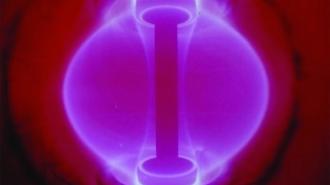Nuclear fusion could be a silver bullet for our energy problems — a practically limitless source of energy, with no carbon emissions or long-lived radioactive waste.
When two atomic nuclei smash into each other with high enough energy, they will fuse into a single nucleus – which is lighter than the combined mass of the original nuclei.
As Einstein described in his most famous equation, E=mc2, this lost mass is converted into a vast amount of energy.
Nuclear fusion could be a silver bullet for our energy problems.
In nature, fusion takes place in the extreme temperatures and pressures of stellar cores. Over the past few decades, physicists have explored how the same process could be harnessed on Earth.
To initiate fusion, researchers often use a reactor shaped like a hollow donut, named a “tokamak.” Using powerful magnets, containing coils of current-carrying wire, these devices are designed to confine a plasma of hydrogen nuclei to their inner walls.
If confined for long enough, the hydrogen can become hot and energetic enough to fuse into helium — releasing a huge amount of energy.
The challenge: In theory, the energy released in the process could then be harvested to sustain the reaction indefinitely. In practice, however, current tokamak designs can’t confine plasma for more than a few seconds at the extreme temperatures needed to initiate fusion.
Some physicists think this challenge could be overcome using a spherical tokamak – shaped more like a cored apple than a donut.
With a far smaller volume than existing designs, this tokamak would be better suited for initiating fusion, with the added benefit of lower construction costs. Yet in order to fit inside the smaller hole in the centres of spherical tokamaks, the magnets in these reactors will also need to be smaller and more powerful than those in their larger, donut-shaped counterparts.
Spherical tokamaks may be able to confine plasma longer than donut-shaped ones.
In existing tokamak designs, magnets often contain tightly-wound wire coils. These can be made from copper, or from low-temperature superconductors, which allow electrical currents to flow through them with zero resistance, but only at temperatures close to absolute zero.
In either case, the wires need to be very well insulated, through a costly, error-prone process.
Superconductors: New materials are now being developed that can maintain their superconducting properties at ever higher temperatures — potentially unlocking the new fusion reactor designs.
In a new study, researchers led by Yuhu Zhai at the Princeton Plasma Physics Laboratory designed a new system for generating magnetic fields suitable for a spherical tokamak.
Their design was based on a new type of high-temperature superconducting cable: a copper core, wrapped in a spiralling superconducting tape. Without any insulation, the researchers spun the cable into a two-layer coil, forming a magnet just 1.6 centimetres across – small enough to be conveniently slotted into the middle of a spherical tokamak.
The new magnet system could be turned on for longer periods and be easier to repair.
With its ability to convey highly concentrated currents at higher temperatures, Zhai’s team calculated that their coil could realistically generate magnetic fields strong enough to confine plasma within a small spherical reactor.
Their approach also had an array of further benefits: since the cable didn’t heat up as quickly as raw copper or low-temperature superconductors, the magnet could be turned on for longer periods without overheating.
In addition, it could operate completely independently from the rest of the tokamak – meaning the coil could be easily taken out and repaired, without any need to re-assemble other parts of the reactor.
Compact fusion: Together, these factors make the team’s magnet ideal for use in future fusion power plants, which would theoretically confine plasma for several months at a time, before routine inspections and repairs are needed.
There are still some technology-related issues that need to be ironed out before researchers can begin to use spherical tokamaks in real fusion experiments. Yet with their innovative design of a powerful, compact, high-temperature superconducting magnet, Zhai’s team hopes that physicists will soon be well on the way to making these experiments a reality in the near future.
If the spherical tokamak can be perfected, our society may come one step closer to harvesting the power of the stars on Earth.
We’d love to hear from you! If you have a comment about this article or if you have a tip for a future Freethink story, please email us at [email protected].






